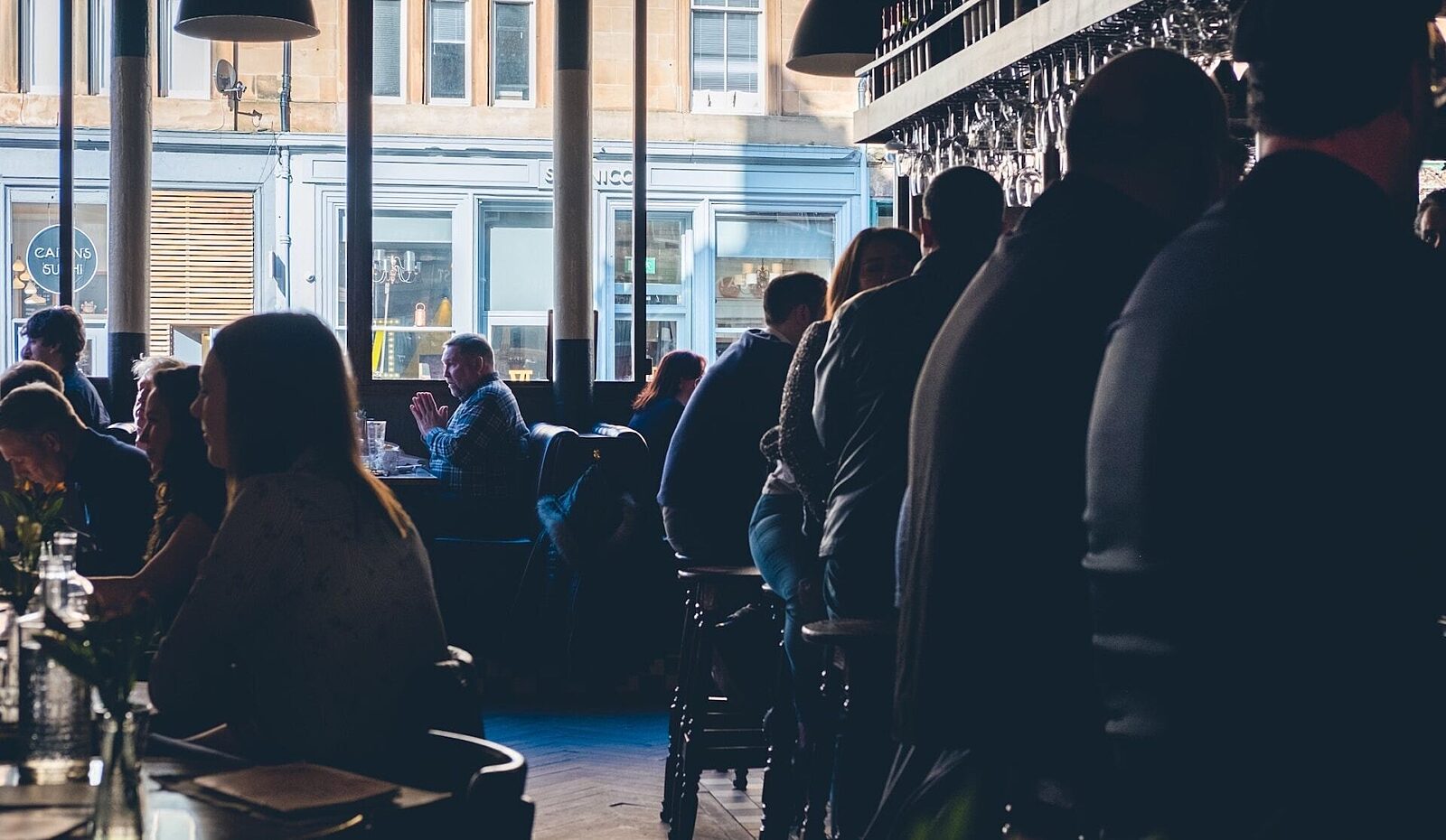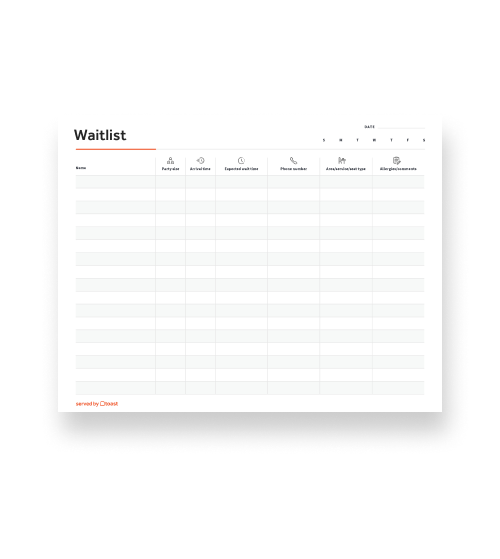
How to Optimize Your Restaurant Waitlist in 2024
The ultimate guide on what restaurant waitlists are, what they should be, and how to best use them in your restaurant business.

Tessa ZuluagaAuthor


Restaurant Waitlist Template
A template to help your host keep track of walk-ins and provide estimated wait times, keeping guests happy and staff organized.
Get free downloadWhat does waiting list mean in restaurant?
A restaurant waitlist is a physical or digital waitlist that tracks walk-ins with party sizes in order so the host can quote accurate wait times.
Managing waitlists has become an increasingly important aspect of operations for restaurants in recent years. Despite economic concerns, Toast’s Q4 Trends Report shows that guests are continuing to enjoy their favorite restaurants. The New York City metropolitan area, for example, saw an approximate 10% increase in average transactions per restaurant location on the Toast platform in Q4 2022. As diners continue to be eager to support restaurants, optimizing your restaurant's waitlist system can help increase revenue and ensure a positive dining experience for guests.
In this article, we'll explore some of the latest strategies and technologies that restaurants can use to streamline their waitlist and maximize their seating capacity in 2023.
What is a restaurant waitlist?
A restaurant waitlist is a physical or digital waitlist that tracks walk-ins with party sizes in order so the host can quote accurate wait times. The restaurant staff may use various methods to manage the waitlist, such as calling out names, sending text message notifications or phone calls, or using a digital display board to inform guests when their table is ready.
Essentially, a waitlist helps your restaurant organize and plan seating arrangements, and provide better service to guests.
Why is your restaurant waitlist important?
Waitlists are an essential tool for restaurants to manage seating arrangements and ensure that customers are served efficiently. They allow restaurants to estimate the number of guests and prepare accordingly. Waitlists can also help prevent overcrowding and ensure that guests are seated in an orderly fashion.
In short, a restaurant waitlist is crucial for 2 reasons: to improve your guest experience and increase overall restaurant efficiency.
Improve customer experience
Your guests are what make your restaurant business thrive. Your waitlist system is one of the first operations your guests come into contact with, and wait times are among the top drivers of customer satisfaction. Customers who have to wait longer than expected are 18% less satisfied with their overall experience.
You can check out other ways to improve customer experience in this article.
Increase restaurant efficiency
A waitlist can help restaurants to optimize table turnover by ensuring that tables are being used as efficiently as possible. This means that when a table is almost finished, the host can send an sms to the next guest on the waitlist, or the next guest with an online reservation. This way, the table can be quickly filled when it becomes available. This process can help to increase the number of customers served over the course of the day.
Host Training Checklist
Use this checklist to help streamline your host training process and ensure that your new hosts get off to a great start.

Types of waitlist software
Instead of using pen and paper, there’s software that can streamline your waitlist process in order to decrease walkaways. When choosing a waitlist management system it’s important to consider options that are best for your specific business. Some factors to consider are:
pricing
reporting
functionality
easy setup
floor plan import
Waitlist widget for websites
sms notifications
There are many different types of restaurant waitlist management systems to help your host stand manage the waiting room and table statuses. Here are a few to check out.
Toast Tables
Toast Tables is Toast's integrated waitlist & reservation solution built to enhance hospitality, simplify table management, and keep guests coming back. This solution enables your restaurant to:
Offer guests the ability to save a spot or track estimated wait times
Anticipate guest needs with notes and preferences
Automate notifications and two-way messaging, allowing guests to communicate changes and help avoid no-shows
Reach more guests via Google Search and Maps with easy access to Reserve a Table directly on your Google Business Profile
Turn tables quickly with real-time updates to help you estimate availability.
Collect guest data, and generate up to $2,800 in sales per campaign with email marketing*
And much more! You can read more about Toast Tables here.
OpenTable
OpenTable is a reservation management solution at its core but has online waitlist capabilities. It allows guests to join the waitlist remotely and notifies parties that their table is ready via text messaging. Opentable’s table management solutions allow restaurant hosts to easily manage the waitlist and communicate with guests.
TablesReady
TablesReady is a virtual waitlist app and online booking website. With TablesReady customers can add themselves to your waitlist through a variety of ways, like your website, a kiosk, text message, scanning a QR code, your host, or a public digital waitlist.
Hostme
Hostme is an Intuitive and Customizable Restaurant Reservation System with features such as waitlist, reservation and table management, server rotation, and CRM for restaurants.
Yelp Waitlist
Yelp is most known as a hub for restaurant industry reviews by customers regarding their dining experiences. However, Yelp for Restaurants also provides a “Guest Manager” solution to book reservations, manage waitlists, and help your front-of-house.
How your restaurant can decrease wait times
As your guests wait for their turn in your dining room, there are a few ways your restaurant can speed up the process. This can be accomplished by properly training your front-of-house staff and making use of modern restaurant technology.
Training your staff
Properly training your staff may seem like an obvious procedure in your restaurant. However, some restaurant management may not train staff to properly reduce wait times. For most restaurants, service can be looked at like a game. The goal of the game is to see how many guests they can shuffle in and out of the restaurant in one shift. To win this game, you need all players on board, starting with the player who starts: your host.
Hosts
Your restaurant host plays an essential role when it comes to floorplan management, seating rotation, and the waitlist. Think of your host stand like a quarterback, they’re making important game-time decisions that will set the rest of your team up for success. A good host is trained to notify guests on the waitlist before the table is actually ready. This gives guests a few minutes to make their way to the host stand. A good host communicates to the rest of the staff and pre-plots their reservations so they don’t over-seat walk-ins. A good host wants to seat as many people as possible but never seats incomplete parties.
Bussers
Your bussers are like linemen, they’re clearing the way for your team to get the job done. Train them how to bus tables as quickly as possible. Station bus buckets strategically around the floor to increase efficiency, and make the job easier. It’s also important that your entire staff is trained on bussing and how to use the dish pit. It’s a team effort!
Servers
To stick with this metaphor, your servers are your wide receivers – it’s up to them to gain as many yards as possible and score. Once a table has been cleaned and sat they need to be trained to turn it as quickly as possible while still providing stellar customer service. Servers should be trained to consolidate their visits to their sections, politely ask campers to leave, and not be afraid to drop the check.
Restaurant New Hire Onboarding Checklist
Bringing new employees onto your team can be both exciting and challenging. Use this free PDF checklist to set your staff up for success.

Technology can help
Technology can also help reduce wait times at restaurants by streamlining the ordering process, optimizing table seating, and improving kitchen efficiency. By using technology in these ways, restaurants can improve the overall guest experience and increase customer satisfaction.
Online menus/QR codes
Online menus and QR codes not only keep your guests entertained while waiting but also help your server turn tables faster. If they review your menu before being seated, they most likely will know what they’ll be ordering sooner. This way, table times decrease, resulting in shorter wait times.
Reservation management
By allowing customers to book their tables online, restaurants can better manage their reservations and reduce the number of walk-ins. Then, your waitlist software can track the expected wait time and notify customers when their table is ready.
Point of sale
A good POS system can increase revenue, streamline operations, and delight guests. Your POS should be a useful tool that helps your staff. For example, Toast’s POS manages orders, sales, and payments in one place with powerful cloud-based software, transparent payment processing and restaurant-grade hardware all built for the restaurant industry by restaurant people.
Kitchen automation
Kitchen automation technology can help restaurants prepare and cook food faster, which can reduce wait times. Automation can include things like digital displays that show order information, and order tracking systems that keep the kitchen staff informed of the status of each order.
How to make a positive waiting experience
Waiting can be frustrating for customers. However, there are things that restaurants can do to create a positive waiting experience.
Keep customers informed – This is where your waitlist and waitlist technology comes in handy. It's important to keep customers informed about how long the wait will be. Using a waitlist management system with a public digital waitlist is an effective way to achieve this.
Provide comfortable seating – If customers need to wait for a table, consider providing comfortable seating in a waiting area. This could include couches, armchairs, or high-top tables. Make sure there is enough space for customers to sit comfortably and that the area is clean and well-lit.
Offer a drink – Consider adding a water station near your waiting area so your guests can have a glass while they wait. Your host can also recommend guests wait at the bar so they can enjoy a beverage before sitting down for their meal.
Show appreciation – After the wait, make sure to thank customers for their patience and apologize for any inconvenience. If a guest had a reservation, and still had to wait at least 25 minutes, consider offering a small gesture. This can be a complimentary dessert or a round of drinks, which can help show customers that their time is valued.
Optimizing your restaurant's waitlist can be a powerful tool for enhancing your customer experience and increasing your revenue in 2023. By leveraging technology, you can provide accurate wait times and offer guests the ability to watch their spot in real time. Implementing these strategies enables your restaurant to enhance its reputation and ensure that your customers keep coming back for more.
So, take the time to analyze your current waitlist system, identify areas for improvement, and make the necessary changes to optimize your waitlist in 2023 and beyond.
*Based on past performance of restaurants using Toast Email Marketing in Q3 and Q4 of 2021. The $2,800 represents the average increase in sales in the 14 days following an email sent via Toast Email Marketing. The average open rate for emails sent via Toast Email Marketing is approximately 39%. Individual results will vary.
Is this article helpful?
DISCLAIMER: This information is provided for general informational purposes only, and publication does not constitute an endorsement. Toast does not warrant the accuracy or completeness of any information, text, graphics, links, or other items contained within this content. Toast does not guarantee you will achieve any specific results if you follow any advice herein. It may be advisable for you to consult with a professional such as a lawyer, accountant, or business advisor for advice specific to your situation.
Read More
Subscribe to On the Line
Sign up to get industry intel, advice, tools, and honest takes from real people tackling their restaurants’ greatest challenges.



